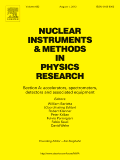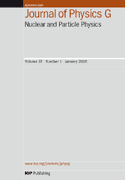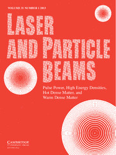
Physical Review Accelerators and Beams
Scope & Guideline
Exploring Innovations in Particle Acceleration
Introduction
Aims and Scopes
- Particle Beam Physics:
Research on the fundamental principles governing particle beam dynamics, including beam stability, emittance, and collective effects. - Accelerator Design and Technology:
Innovations in the design and optimization of various types of accelerators, such as synchrotrons, linacs, and plasma-based accelerators. - Beam Diagnostics and Control:
Development of advanced diagnostic techniques for beam characterization, monitoring, and control systems to enhance performance. - Machine Learning Applications:
Integration of machine learning methodologies in accelerator physics to optimize operational parameters and improve diagnostic capabilities. - Novel Acceleration Techniques:
Exploration of new acceleration mechanisms, including laser-driven, wakefield, and other advanced techniques for high-energy physics applications. - Superconducting Technology:
Investigations into superconducting materials and their applications in enhancing accelerator performance and efficiency. - Applications in Medicine and Industry:
Research on the application of particle accelerators in medical therapies, materials science, and other industrial applications.
Trending and Emerging
- Machine Learning and AI in Accelerator Physics:
There is a growing trend in utilizing machine learning and artificial intelligence techniques for optimizing accelerator operations and diagnostics, showcasing the intersection of data science and physics. - Advanced Beam Manipulation Techniques:
Emerging studies focus on novel methods for manipulating beam properties, such as advanced shaping and compression techniques, which are crucial for enhancing beam quality. - Plasma Acceleration Research:
Plasma-based acceleration methods are gaining increased attention due to their potential for achieving high gradients and compact accelerators. - High-Intensity and High-Charge Beams:
Research into high-intensity and high-charge particle beams is trending, driven by the need for more powerful and efficient accelerators for various applications. - Integration of Quantum Technologies:
The exploration of quantum technologies and their potential applications in particle accelerators reflects an emerging interdisciplinary field that combines quantum mechanics with accelerator physics. - Sustainability in Accelerator Design:
There is a growing emphasis on sustainability and energy efficiency in accelerator design, motivated by the global push for greener technologies.
Declining or Waning
- Traditional Linear Accelerators:
While still relevant, the frequency of research specifically targeting conventional linear accelerators has decreased as newer technologies such as plasma accelerators gain prominence. - Low-Energy Particle Physics:
Research focused on low-energy particle physics applications has become less frequent, possibly due to a shift towards high-energy and high-intensity applications. - Basic Material Studies:
Investigations centered solely on material properties without direct application to accelerator technology are less common as practical applications take precedence. - Single-Particle Tracking:
The specific study of single-particle tracking techniques has diminished as integrated diagnostics and machine learning approaches gain traction. - Static Beam Dynamics:
Research that does not consider dynamic or real-time beam dynamics has seen a decline, as the focus shifts towards more adaptive and responsive systems.
Similar Journals

Physics of Particles and Nuclei Letters
Unveiling the Mysteries of Particles and NucleiPhysics of Particles and Nuclei Letters, published by PLEIADES PUBLISHING INC, serves as a pivotal platform for the dissemination of cutting-edge research in the domains of particle and nuclear physics. With an ISSN of 1547-4771 and an E-ISSN of 1531-8567, this journal has been actively contributing to the scientific community since its inception in 2006 and continues to be influential, with a convergence period extending to 2024. While its open access options are limited, the journal is recognized for its rigorous peer-review process and commitment to quality, as reflected in its Scopus rankings across multiple categories, including a Q3 in Nuclear and High Energy Physics and Radiation in 2023. The journal is positioned to be a vital resource for researchers aiming to bridge theoretical understanding with practical applications in these highly specialized fields, fostering advances that resonate within atomic and molecular physics, radiology, and beyond. Its relevance continues to grow as the global scientific community seeks innovative solutions to complex problems in modern physics.

NUCLEAR INSTRUMENTS & METHODS IN PHYSICS RESEARCH SECTION A-ACCELERATORS SPECTROMETERS DETECTORS AND ASSOCIATED EQUIPMENT
Pioneering research in nuclear methods and technologies.NUCLEAR INSTRUMENTS & METHODS IN PHYSICS RESEARCH SECTION A is a leading journal published by Elsevier, dedicated to the advancements in accelerators, spectrometers, detectors, and associated equipment relevant to the fields of nuclear and high energy physics. With its ISSN 0168-9002 and E-ISSN 1872-9576, this journal fosters knowledge sharing among physicists and researchers globally, providing a critical platform for both theoretical and experimental studies. Currently ranked in the Q2 quartile for both Instrumentation and Nuclear and High Energy Physics, the journal maintains a robust position in the competitive Scopus rankings, with noteworthy placements that underline its scholarly impact. As of 2023, it occupies the 38th rank in Nuclear and High Energy Physics and the 79th in Instrumentation, illustrating its relevance in the scientific community. Covering research spanning from its inception in 1983 to the projected completion in 2024, the journal caters to a diverse audience of researchers, professionals, and students eager to stay abreast of the latest innovations and techniques in the realm of nuclear instrumentation. Although it primarily operates under subscription-based access, it is instrumental in disseminating pivotal findings and experimental methodologies that drive progress in the scientific community.

EUROPEAN PHYSICAL JOURNAL A
Catalyzing Advances in High Energy Physics ResearchEUROPEAN PHYSICAL JOURNAL A (EPJ A), published by Springer, is a premier journal in the field of Nuclear and High Energy Physics, dedicated to fostering innovative research and scholarly communication within the scientific community. With an impressive impact factor that reflects its significant contribution to the discipline, EPJ A ranks in the Q1 category and boasts a Scopus rank of 24 out of 87, placing it in the 72nd percentile of its field for 2023. This journal, with its ISSN 1434-6001 and E-ISSN 1434-601X, embraces a commitment to open access, ensuring that cutting-edge research is accessible to a global audience. With coverage from 1998 to 2024, EPJ A continues to be a vital resource for researchers, professionals, and students alike, promoting collaboration, knowledge sharing, and advancements in the vast landscape of nuclear physics and high-energy interactions. Located in Germany with a representative address in New York City, this journal serves as a bridge for international scientific discourse.

Nuovo Cimento C-Colloquia and Communications in Physics
Advancing Knowledge from 1978 to TodayNuovo Cimento C-Colloquia and Communications in Physics is a distinguished peer-reviewed journal published by the SOC ITALIANA FISICA, dedicated to the dissemination of novel research and communications in the vibrant fields of Astronomy and Physics. Established in 1978, this journal provides a platform for scientists and researchers to present their findings, fostering academic dialogue and collaboration within the community. As of 2023, the journal holds a Q4 quartile ranking in both Astronomy and Astrophysics and Physics and Astronomy (miscellaneous), reflecting its commitment to contributing to the scientific corpus despite its emerging status in the competitive landscape. Based in Italy, the journal is accessible to a global audience, enhancing its reach and influence. Although currently not an open access journal, it remains an essential resource for researchers and professionals seeking to stay informed on cutting-edge developments in physics and astronomy. Its ongoing convergence of knowledge from 1978 to 2024 promises to enrich the scholarly discourse and advance the frontiers of research in these dynamic fields.

Journal of Instrumentation
Fostering collaboration in the realm of instrumentation and physics.Journal of Instrumentation, published by IOP Publishing Ltd, stands at the forefront of the fields of instrumentation and mathematical physics, playing a crucial role in advancing the knowledge and practice within these domains. With an ISSN of 1748-0221 and an esteemed position as a Q2-ranked journal in both categories as of 2023, it showcases high-quality research and innovative findings that contribute to the broader scientific community. Operating since 2006, this journal facilitates the dissemination of cutting-edge developments and interdisciplinary approaches in measurement techniques and their applications, making it a vital resource for researchers, professionals, and students alike. The journal maintains a competitive edge, ranked in the 59th percentile in mathematical physics and the 35th percentile in instrumentation according to Scopus rankings, reflecting its commitment to quality and impact. With a focus on accessible scientific communication, the Journal of Instrumentation is dedicated to nurturing a collaborative environment that promotes the integration of theoretical advancements and practical issues, providing an essential platform for sharing vital research discoveries.

Bulletin of the Lebedev Physics Institute
Illuminating the path of scientific inquiry since 2009.Bulletin of the Lebedev Physics Institute is a peer-reviewed journal dedicated to advancing the field of physics and astronomy, published by PLEIADES PUBLISHING INC. With a print ISSN of 1068-3356 and an e-ISSN of 1934-838X, this journal has been an essential platform for disseminating significant research findings since its inception in 2009. It continues to provide insight into various areas of general physics and astronomy, and consistently aims to foster innovative discussions among researchers and scholars. Although currently positioned in the Q4 category within the 2023 Scopus rankings, it serves a vital role in linking emerging trends with established research, catering to a global audience seeking to explore complex concepts within the field. By contributing to the body of knowledge, the Bulletin supports academic growth and collaboration across diverse sectors. Despite its challenges in ranking, the journal’s unique perspectives and ongoing publications underscore its commitment to pushing the boundaries of scientific inquiry in the United States and beyond.

JOURNAL OF PHYSICS G-NUCLEAR AND PARTICLE PHYSICS
Advancing the Frontiers of Nuclear and Particle PhysicsJOURNAL OF PHYSICS G-NUCLEAR AND PARTICLE PHYSICS, published by IOP Publishing Ltd, stands as a premier journal in the realm of Nuclear and High Energy Physics. With an established presence since 1989 and currently converging toward 2024, this influential journal emphasizes groundbreaking research and discoveries in particle physics, fostering the dissemination of knowledge among a global audience of researchers, professionals, and students. Recognized for its high-quality publications, it holds a Q1 ranking in its category for 2023, placing it at an impressive 87th percentile among 87 journals in its field as per Scopus Rankings. The journal's impact is reflected in its esteemed reputation, making it an essential resource for advancing the frontiers of physics. Although it currently does not operate under an open access model, the journal ensures that subscribers receive comprehensive insights into the latest developments and theoretical advances that shape our understanding of the universe.

INTERNATIONAL JOURNAL OF MODERN PHYSICS A
Elevating research standards in contemporary physics.INTERNATIONAL JOURNAL OF MODERN PHYSICS A, published by WORLD SCIENTIFIC PUBL CO PTE LTD, stands as a pivotal platform in advancing the frontiers of research within the fields of Astronomy and Astrophysics, Atomic and Molecular Physics, and Nuclear and High Energy Physics. Established in 1989, this journal has systematically contributed to the scientific community, with a demonstrated impact as indicated by its Q2 category rankings across these critical disciplines in 2023. Researchers and professionals are encouraged to engage with its rigorous peer-reviewed content, fostering a deeper understanding of modern physics theories and experimental breakthroughs. Although the journal operates under a conventional access model, it remains a vital resource for those seeking to disseminate their findings and stay abreast of cutting-edge developments. With an emphasis on quality and breadth of research, the journal continues to attract submissions from leading physicists and scholars, enhancing its reputation as a key academic resource.

RIVISTA DEL NUOVO CIMENTO
Pioneering Insights for a Brighter Scientific Future.RIVISTA DEL NUOVO CIMENTO, published by SPRINGERNATURE, is a prestigious journal dedicated to advancing research in the field of physics and astronomy. Established in 1969, this journal has consistently delivered high-quality, peer-reviewed articles that explore emerging topics and significant developments in the broad scope of general physics. With an impressive Q1 ranking in the 2023 category for Physics and Astronomy and a remarkable Rank #23/243 in Scopus, it is recognized as a leading resource, standing in the 90th percentile of its field. Although not an open-access journal, RIVISTA DEL NUOVO CIMENTO ensures wide dissemination of its impactful content, making it essential reading for researchers, professionals, and students who are eager to stay ahead in their academic pursuits. Join a vibrant community dedicated to excellence and innovation in physics and astronomy by exploring the cutting-edge works published in this esteemed journal.

LASER AND PARTICLE BEAMS
Advancing the Frontiers of Laser and Particle ResearchLASER AND PARTICLE BEAMS is a distinguished peer-reviewed journal published by Hindawi Ltd, specifically focusing on the fields of atomic and molecular physics, optics, condensed matter physics, and electrical and electronic engineering. With its commitment to advancing knowledge in these areas, the journal has transitioned to an Open Access model since 2021, ensuring that research findings are readily accessible to the global scientific community. Covering an extensive publication history from 1983 to 2023, it serves as an important platform for researchers, professionals, and students interested in the latest developments and applications of laser technologies and particle beam methodologies. Although currently categorized in Q4 for two of its areas and Q3 for electrical engineering in the 2023 base metrics, LASER AND PARTICLE BEAMS is positioned to foster innovative research and discussions within the laboratory and applied settings, contributing significantly to advancements in its respective disciplines. The journal encourages contributions that push the boundaries of knowledge and seeks to attract a diverse array of submissions to enhance its impact in the scientific community.